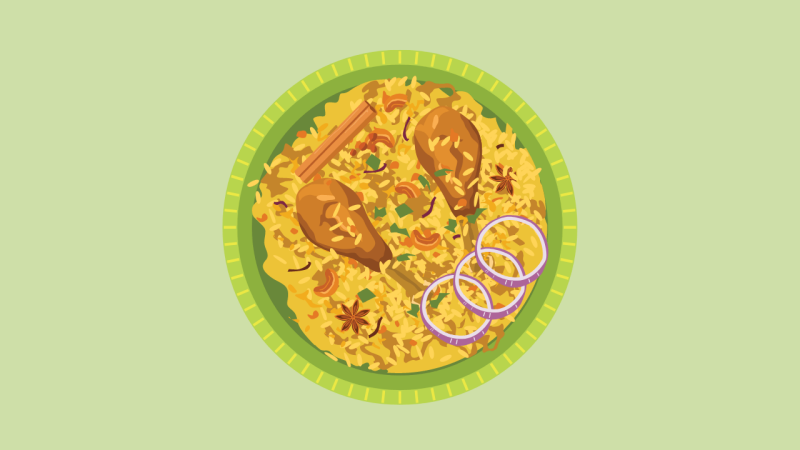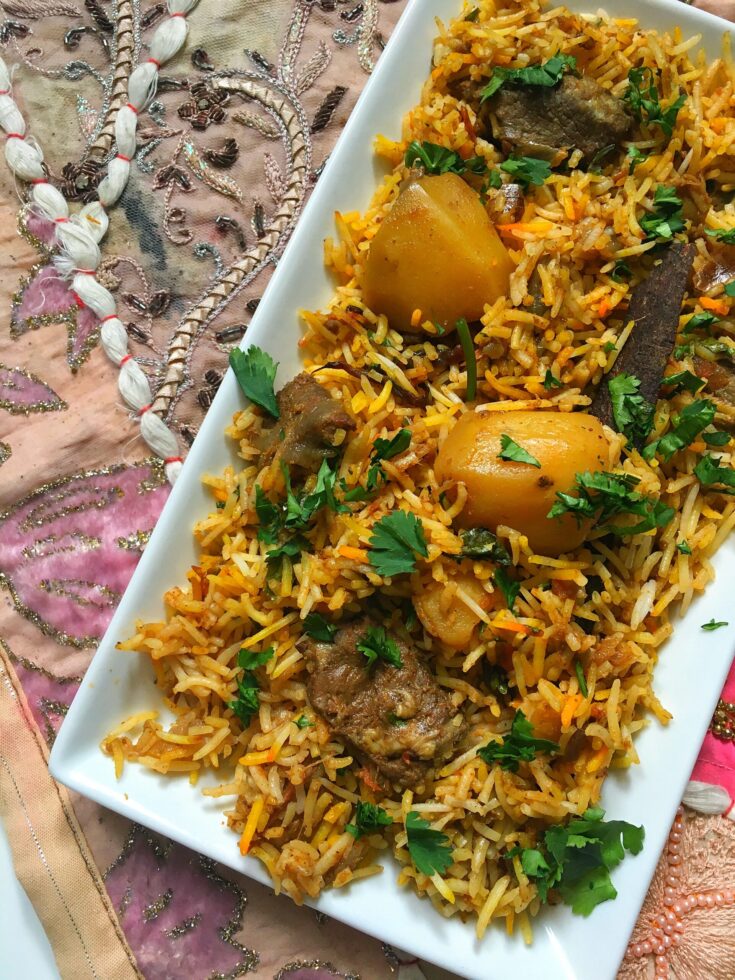ghazi52
PDF THINK TANK: ANALYST

- Joined
- Mar 21, 2007
- Messages
- 103,901
- Reaction score
- 106
- Country
- Location
,
Queenie Shaikh
23 Apr, 2023
There are two categories of South Asians in this world — category A loves biryani, and category B loves biryani a little too much. I proudly belong in the second category, classified as a biryani fiend among family and friends, and a biryani snob among those who do not understand how difficult it is to find the perfect Pakistani blend of meat and rice in London.
Indeed, it is a fact that I reside in one of the most diverse cities in the world, but the quest for an unadulterated, non-whitewashed version of biryani is as arduous as spotting the moon on Chand Raat in Pakistan.
It usually entails browsing through numerous online menus, scrutinising photographs of the dish to determine which restaurant offers the most authentic version, and assessing whether the exorbitant prices in London truly reflect the authenticity they claim to provide.
During childhood, my adoration for this divine delicacy was even more intense. I used to associate it with Fridays when the spicy scent would strike my post-school appetite with full force. After Papa’s return from Jumma prayers, we would come together as a family to relish biryani.
A fight or two would ensue over who “stole” the most aaloos, and as the youngest member and brat of the family, I’d get away with as many as my heart desired.
Eid would be a similar affair. My family would always host lunch on the first day, and an extensive menu would be prepped weeks in advance.
“Iss saal Eid pay kya banayein [what should we make this Eid]?” Mum would ask every year.
“Biryani,” I’d automatically voice my usual, non-brainer response.
“Biryani tou banay gee hee, per uss kay ilawa kya banayein [Biryani will obviously be made, but what else]?” Mum would ask.
“Biryani with raita and salad,” I’d reply as Mum would jokingly roll her eyes.

While I recognise the cultural norm of serving a lavish spread during festivities like Eid, I firmly believe that biryani alone is a sufficient and wholesome meal, one that even royalty used to relish.
Steeped in rich history and cultural heritage, its origins can be traced back to Iran. The word “biryani” comes from the Persian word “birian,” which means “fried before cooking.” The South Asian version of the mixed rice dish seemingly has its origins among Muslims of the Indian subcontinent, however, there’s no one theory that factually sticks.
Historians attribute the creation of the renowned Indian cuisine to the Mughal Empire, who are believed to have developed it during their rule between the 15th and 19th centuries. They were lauded for their mastery in transforming cooking into an art form, and for introducing several dishes to the Subcontinent, including biryani, pulao (pilaf), and kebabs.
It is believed that the Mughal Empire introduced biryani to Northern India, where it was known as “pakki” biryani due to its pre-cooked nature and assembly in a large daig (pot) before being put on dum (slow-cooked) for final preparation.
This method was similar to the Iranian way of cooking biryani. The marinated meat would slowly cook in its own juices, creating a harmonious blend with the layered rice and aromatic ingredients. Given the Mughal Empire’s reputation for lavishness, one variation of the dish is also referred to as “Mughlai biryani.”
Legend has it that Mumtaz Mahal — the wife and queen of Shahjahan and the muse behind the Taj Mahal — once visited the army barracks and was dismayed to find the soldiers weak and malnourished. She beseeched the royal head chef to create a dish that would combine meat and rice to provide the soldiers with balanced nutrition, and thus, biryani was born. Similar anecdotes are also attributed to the Nizams of Hyderabad and the Nawabs of Lucknow, who were renowned in history for their deep appreciation and understanding of biryani’s nuances.
On the other hand, the likelihood is higher that the dish was first brought to the Deccan region in South India by crusaders and statesmen.There are records of a rice dish called Oon Soru in Tamil literature as early as 2 AD, which was made of rice, ghee, meat, turmeric, coriander, pepper, and bay leaf, and used to feed warriors.

In the present day, biryani has evolved into over 30 different variations across South Asia and the Middle East, constantly changing and adapting. Even now, it’s a labour-intensive dish that requires patience, skill, and attention to detail, taking hours of cooking and simmering to bring it to perfection.
The traditional Pakistani biryani still holds true to its roots, with precise measurements of ingredients, a well-balanced blend of spices, and a practised technique. The traditional dum pukht method remains widely used, where ingredients are slowly cooked (sometimes over charcoal) in a daig or daigchi, sometimes from the top, allowing the steam to delicately tenderise the meat in its own juices while infusing the rice with flavours. The daig is sealed with dough or, in a purely desi fashion, an old newspaper around the edges to trap the steam.
The rice is usually basmati, which is known for its fragrant aroma and delicate flavour. The meat can be chicken, lamb, beef, or even various forms of seafood, depending on the region, personal preferences, and dietary requirements. The spices used in biryani are usually what give the dish its signature flavour.
Similar to the grand lifestyle of the Mughal Empire, post-Ramazan festivities demand a certain level of flair and culinary indulgence. Biryani is more than just a dish on Eid. It represents an emotion, a tradition, and a cultural symbol. In our family home, the day of Eid would always be filled with excitement.
Relatives would arrive with Eidi and meetha, and the delightful aroma of biryani would fill the air. Even though the table was always adorned with our finest china, savouring a bite directly from the biryani daig would bring a whole new level of satisfaction…even if it meant getting told off for poor table manners.
The sound of clanging cutlery and plates accompanied by oohs and aahs of appreciation is etched in my memory as we’d relish every mouthful of biryani. It was a moment of pure joy, togetherness, celebration, and of course, the inevitable food coma.
This mental picture of our family happily chowing down on multiple helpings is what biryani on Eid represents to me.
It also depicts the love and affection of family and friends, the cultural legacy that we cherish, and the generous spirit that is central to Islam. Although I have (somewhat) mastered the art of cooking it on my own — thanks to London’s non-existent authentic biryani situation — without relying on the aid of Shan or National masala, the taste of biryani in Pakistan remains unparalleled. Karachi in particular exudes an authentic and familiar vibe that cannot be easily replicated anywhere else.
So, as you come together with your loved ones around the Eid table this year, take a moment to relish the rich flavours of biryani. Let it transport you to a place of pure euphoria, where tradition and culture come alive, and where the indulgence of this heavenly food item leads to a blissful culinary slumber. And amidst the festivities, don’t forget to express gratitude to your mum or any other family member who prepared it with love and care.
For at the heart of Eid celebrations lies the essence of love, loved ones, and the pleasure of savouring truly delicious biryani.
..,,.

What makes biryani so special?
The flavours of this royal dish have a rich history and perfectly complement the joy of Eid.Queenie Shaikh
23 Apr, 2023
There are two categories of South Asians in this world — category A loves biryani, and category B loves biryani a little too much. I proudly belong in the second category, classified as a biryani fiend among family and friends, and a biryani snob among those who do not understand how difficult it is to find the perfect Pakistani blend of meat and rice in London.
Indeed, it is a fact that I reside in one of the most diverse cities in the world, but the quest for an unadulterated, non-whitewashed version of biryani is as arduous as spotting the moon on Chand Raat in Pakistan.
It usually entails browsing through numerous online menus, scrutinising photographs of the dish to determine which restaurant offers the most authentic version, and assessing whether the exorbitant prices in London truly reflect the authenticity they claim to provide.
During childhood, my adoration for this divine delicacy was even more intense. I used to associate it with Fridays when the spicy scent would strike my post-school appetite with full force. After Papa’s return from Jumma prayers, we would come together as a family to relish biryani.
A fight or two would ensue over who “stole” the most aaloos, and as the youngest member and brat of the family, I’d get away with as many as my heart desired.
Eid would be a similar affair. My family would always host lunch on the first day, and an extensive menu would be prepped weeks in advance.
“Iss saal Eid pay kya banayein [what should we make this Eid]?” Mum would ask every year.
“Biryani,” I’d automatically voice my usual, non-brainer response.
“Biryani tou banay gee hee, per uss kay ilawa kya banayein [Biryani will obviously be made, but what else]?” Mum would ask.
“Biryani with raita and salad,” I’d reply as Mum would jokingly roll her eyes.

While I recognise the cultural norm of serving a lavish spread during festivities like Eid, I firmly believe that biryani alone is a sufficient and wholesome meal, one that even royalty used to relish.
Steeped in rich history and cultural heritage, its origins can be traced back to Iran. The word “biryani” comes from the Persian word “birian,” which means “fried before cooking.” The South Asian version of the mixed rice dish seemingly has its origins among Muslims of the Indian subcontinent, however, there’s no one theory that factually sticks.
Historians attribute the creation of the renowned Indian cuisine to the Mughal Empire, who are believed to have developed it during their rule between the 15th and 19th centuries. They were lauded for their mastery in transforming cooking into an art form, and for introducing several dishes to the Subcontinent, including biryani, pulao (pilaf), and kebabs.
It is believed that the Mughal Empire introduced biryani to Northern India, where it was known as “pakki” biryani due to its pre-cooked nature and assembly in a large daig (pot) before being put on dum (slow-cooked) for final preparation.
This method was similar to the Iranian way of cooking biryani. The marinated meat would slowly cook in its own juices, creating a harmonious blend with the layered rice and aromatic ingredients. Given the Mughal Empire’s reputation for lavishness, one variation of the dish is also referred to as “Mughlai biryani.”
Legend has it that Mumtaz Mahal — the wife and queen of Shahjahan and the muse behind the Taj Mahal — once visited the army barracks and was dismayed to find the soldiers weak and malnourished. She beseeched the royal head chef to create a dish that would combine meat and rice to provide the soldiers with balanced nutrition, and thus, biryani was born. Similar anecdotes are also attributed to the Nizams of Hyderabad and the Nawabs of Lucknow, who were renowned in history for their deep appreciation and understanding of biryani’s nuances.
On the other hand, the likelihood is higher that the dish was first brought to the Deccan region in South India by crusaders and statesmen.There are records of a rice dish called Oon Soru in Tamil literature as early as 2 AD, which was made of rice, ghee, meat, turmeric, coriander, pepper, and bay leaf, and used to feed warriors.

In the present day, biryani has evolved into over 30 different variations across South Asia and the Middle East, constantly changing and adapting. Even now, it’s a labour-intensive dish that requires patience, skill, and attention to detail, taking hours of cooking and simmering to bring it to perfection.
The traditional Pakistani biryani still holds true to its roots, with precise measurements of ingredients, a well-balanced blend of spices, and a practised technique. The traditional dum pukht method remains widely used, where ingredients are slowly cooked (sometimes over charcoal) in a daig or daigchi, sometimes from the top, allowing the steam to delicately tenderise the meat in its own juices while infusing the rice with flavours. The daig is sealed with dough or, in a purely desi fashion, an old newspaper around the edges to trap the steam.
The rice is usually basmati, which is known for its fragrant aroma and delicate flavour. The meat can be chicken, lamb, beef, or even various forms of seafood, depending on the region, personal preferences, and dietary requirements. The spices used in biryani are usually what give the dish its signature flavour.
Similar to the grand lifestyle of the Mughal Empire, post-Ramazan festivities demand a certain level of flair and culinary indulgence. Biryani is more than just a dish on Eid. It represents an emotion, a tradition, and a cultural symbol. In our family home, the day of Eid would always be filled with excitement.
Relatives would arrive with Eidi and meetha, and the delightful aroma of biryani would fill the air. Even though the table was always adorned with our finest china, savouring a bite directly from the biryani daig would bring a whole new level of satisfaction…even if it meant getting told off for poor table manners.
The sound of clanging cutlery and plates accompanied by oohs and aahs of appreciation is etched in my memory as we’d relish every mouthful of biryani. It was a moment of pure joy, togetherness, celebration, and of course, the inevitable food coma.
This mental picture of our family happily chowing down on multiple helpings is what biryani on Eid represents to me.
It also depicts the love and affection of family and friends, the cultural legacy that we cherish, and the generous spirit that is central to Islam. Although I have (somewhat) mastered the art of cooking it on my own — thanks to London’s non-existent authentic biryani situation — without relying on the aid of Shan or National masala, the taste of biryani in Pakistan remains unparalleled. Karachi in particular exudes an authentic and familiar vibe that cannot be easily replicated anywhere else.
So, as you come together with your loved ones around the Eid table this year, take a moment to relish the rich flavours of biryani. Let it transport you to a place of pure euphoria, where tradition and culture come alive, and where the indulgence of this heavenly food item leads to a blissful culinary slumber. And amidst the festivities, don’t forget to express gratitude to your mum or any other family member who prepared it with love and care.
For at the heart of Eid celebrations lies the essence of love, loved ones, and the pleasure of savouring truly delicious biryani.
..,,.

What makes biryani so special?
The flavours of this royal dish have a rich history and perfectly complement the joy of Eid.
images.dawn.com










